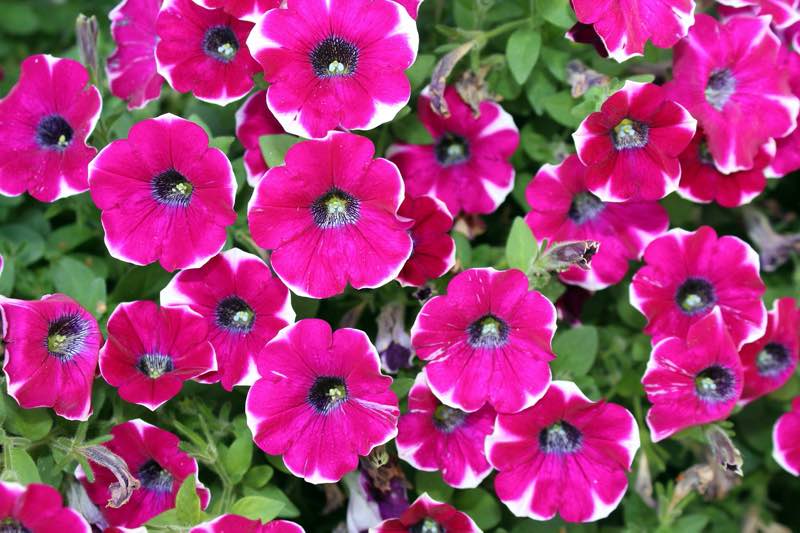
Petunias are not just any garden flowers—they’re colorful, fast-growing, and incredibly beautiful, perfect for brightening up any space. Native to South America and with a French name to boot, these charming blooms have been gracing gardens for centuries. If you want to grow them yourself, we’ve got all the essential tips and everything you need to know about petunias, from types to care to symbolism.
What Are Petunias?
- Common Name: Petunia
- Scientific Name: Petunia Atkinsiana
- Family: Solanaceae (yes, they’re related to tomatoes, potatoes, and even tobacco!)
- Height: Typically 12 to 18 inches
- Colors: Petunias come in a variety of colors—pink, white, purple, and even black! Some have a unique spotted pattern.
- Foliage: The leaves are pale to deep green and have a slightly sticky, hairy texture.
Types of Petunias
Petunias are divided into four main categories. Each type offers something unique, whether it’s size, growth pattern, or color.
- Grandiflora Petunias
These are the most popular and come with large, eye-catching blooms up to 3 inches across. They’re perfect for hanging baskets or window boxes and often feature a cascade of flowers. Examples: Storm, Supercascade, Dream. - Multiflora Petunias
These smaller flowers (1–1.5 inches) are compact and work great in tight containers or garden beds. They bloom profusely but require regular deadheading to keep them growing. Examples: Celebrity, Primetime, Horizon. - Milliflora Petunias
These mini blooms, about 2 inches across, are known for their vibrant colors and ability to withstand wind and rain. They’re great for adding a splash of color to any garden. Examples: Fantasy, Picobella. - Wave Petunias
True to their name, these petunias spread out widely, making them perfect for ground cover or hanging pots. They can cover up to 4 feet in a single growing season but need lots of water and regular feeding. Examples: Avalanche, Easy Wave, Shock Wave.
Growing Petunias: Tips for Success
Petunias are easy to grow, whether you plant them in your garden or in containers. Here are a few essential tips to help you succeed:
- Temperature
Petunias love warmth but are sensitive to frost. If you live in a cooler climate, make sure to plant them after the danger of frost has passed. They don’t thrive in extremely hot temperatures either, as it can cause them to stop blooming. - Soil
These flowers prefer slightly acidic, well-drained soil. Make sure the soil is fertile and well-fed for the best results. Poor soil can lead to poor blooming. - Watering
Petunias love their soil moist but not soggy. Water deeply but avoid overwatering. Let the soil dry out slightly between waterings, and always ensure good drainage. - Fertilizing
Use a balanced fertilizer (like 12-12-12) to keep your petunias thriving. You can switch to a liquid fertilizer mid-summer for an extra boost. Just don’t overdo it—too much fertilizer can harm the plants. - Diseases and Pests
Petunias are relatively resistant to pests and diseases, but they can sometimes fall prey to aphids, budworms, or mold. If you notice pests, simply hose down the plants with water (being careful not to drown the roots).

Growing Petunias from Seed
Starting petunias from seed is simple and rewarding. Here’s how you can do it:
- Start Indoors
Sow the seeds indoors 8–10 weeks before the last frost date in your area. Lightly press the seeds into the soil, as they need light to germinate. - Soak the Seeds
Before planting, soak the seeds for a day in warm water to help them sprout faster. - Transplant
Once the seedlings have true leaves, you can transplant them into larger pots or directly into your garden. - Watch Them Bloom
It takes about 100 days from planting to bloom, so patience is key.
Deadheading Petunias
To keep your petunias blooming all season, you’ll want to remove dead flowers regularly. Here’s how to deadhead effectively:
- Inspect
Look for dead or withered blooms. Even those that still have seeds can be removed to encourage fresh growth. - Cut the Stems
Use pruning scissors to cut the spent blooms right at the stem, just beneath the flower. You can leave the stem intact. - Trim the Plant
If your petunia plant looks leggy or overgrown, you can trim it back by up to half to encourage new growth.
Petunia Varieties to Try
If you’re unsure where to start, here are a few petunia varieties that are popular and beautiful:
- Supertunia Silver: Light-colored with a lavender core and veins, this variety is striking.
- Blue Spark Cascadia: A violet flower with a sweet fragrance—perfect for any garden.
- Prism Sunshine: Large, buttery yellow blooms that are weather-resistant.
Petunia Symbolism
Petunias have come a long way from their early days when they symbolized resentment. Today, they stand for a variety of positive meanings, such as:
- Resentment (Historically)
- Originally, petunias symbolized negative emotions, perhaps because they were not embraced by early European colonists.
- Modern Meaning
- Today, petunias are more commonly associated with feelings of love, well-being, and beauty. They represent admiration and are often gifted to celebrate positive emotions.
Final Thoughts
Petunias are easy-to-grow, vibrant flowers that can add charm and color to your garden, whether you’re growing them in the ground or in containers. With the right care, you can enjoy their gorgeous blooms all season long. So, why not start planting your petunias today and add a little splash of beauty to your space?
